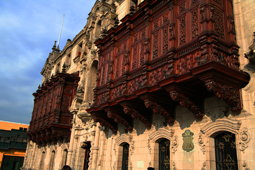APEC 2008 Peru: When business met pleasure

Peru does nothing half-heartedly. The APEC economy synonymous with passion, hearty cuisine and the renowned Pisco Sour carried out its 2008 chairmanship with trademark zeal.
In the same year as the world woke up to one of the greatest economic downturns in history, Peru received leaders from the world's most influential economies; forged Free Trade Agreements with the US, Canada, Singapore, China, and Chile; began talks with South Korea; signed an investment treaty with Japan; and announced its will to join the Trans Pacific Free Trade Agreement (P4+3).
That Peru was, quite simply, an impeccable host (think Martha Stewart meets Shakira) is not the least of its drawing cards. Peru is a shining example of how an economy can use APEC as an opportunity to market itself to a broader audience. It had been featured on Discovery Channel, foodie networks and in the news. But hosting APEC scrubbed the sand off Peru's untamed image to reveal a surprisingly under-publicised sophistication.
During Leaders' Week alone, the Peruvian Immigration reported the arrival of an approximate 4,839 visitors. Apart from immediate and direct impact to the hospitality sector, continuous APEC media coverage throughout the year meant that Peru was on everyone's mind. Note the presence of 2,500 international journalists to cover APEC in November.
It's not that Peru was not a hot destination before APEC. Indeed, to hike the Inka Trail or to see Machu Picchu - one of the world's wonders - is on the wish lists of dreamers throughout the world. But over the course of the APEC 2008 year, Peru received more than 2 million tourists1 - an increase of 17 percent over the previous year.
In Cusco, where annual tourist growth grew by 10 percent, the increase has been attributed to exposure among a new Asian market. Directur-Cusco representative, Jean Paul Benavente explained to Andina (Peruvian news source) that, "It is remarkable how the 'Peru and Cusco' product was positioned in these meetings... In the APEC Leaders' official declaration ceremony, a large picture of Machu Picchu was observed at the back of the room."
Tourism is considered by many an additional string to Peru's economic bow. With immigration agents trained in English language skills and significant investments in the four and five star hotel industry, Peru is now even better equipped to capitalise both on the tourist market as well as to visitors exploring business opportunities. In fact, almost one third of its visitors entering Peru last year did so for business purposes. Foreign direct investment doubled in 2008 and is estimated to triple in 20092.
The Free Trade Agreement between Peru and China was a flagship moment in the partnership that has become increasingly synergistic as of late. Chinese firms recently committed to invest around USD 6 billion in Peru's mining sector3, presumably increasing employment and stimulating the national economy. Conversely, the ensuing profits to China are intended to extend electric capacity to previously under-serviced rural areas. China has expressed its will to deepen both political relations and mutually beneficial trade and many have noted a significant strengthening of Sino-Latin American relations.
Peru also welcomed trade missions from Russia and Singapore. Russian President Medvedev's delegation included heads of the VTB Bank as well as Gazprom and marked the first major Russian initiative in Latin America since the Cold War.
Apart from the investments of large scale and government-owned enterprises, however, APEC 2008 provided a forum for small and medium sized business owners to make valuable international liaisons.
Direct interaction and exposure to the unique products found in Peru inspired a collaborative effort with the USA. This year, a group of 50 Peruvian women will be trained in a programme specifically designed for women SME owners in developing countries. The programme, which includes modules in packaging, distribution, product adaptation and design, will target women in textile, jewellery and agriculture industries. Once their training is complete, "business matching" will assist women to identify specific markets for their products and, as a complement to the effort, the USA will assist in bringing the programmes' top graduates to exhibit their products on the margins of the 2009 APEC Women Leaders' Network meeting in Singapore.
A "train the trainer" approach has been employed so that knowledge may be propagated and, ideally, expanded to include other APEC economies.
There is no question that APEC meetings are an inconvenience the economies that host them. Traffic is slower, streets more congested and security heavier. They also lead to a lot of work - a lot of employment, a lot of learning and a lot more business. It may be said that after hosting APEC, an economy is never quite the same. APEC leaves its mark. Reciprocally, Peru has left a mark on APEC and many projects initiated in 2008 will contribute indefinitely to the body that inspired them.
- According to the Prom Peru (Peruvian Tourism Board) figures
- Extract from Leader of the Year: Alan Garcia: Peruvian President Alan Garcia boosts foreign investment and helps spur economic growth, by Joachim Bamrud, Latin Business Chronicle
- Economist Intelligence Unit

